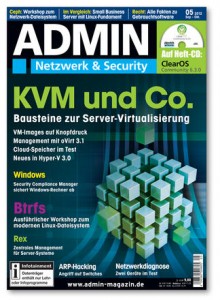In der aktuellen Ausgabe des Admin-Magazins habe ich einen kleinen Artikel über das Thema-Autodiscovery (komischerweise nicht die Lösung aller Probleme) geschrieben. Neben ein paar klassischen Ansätzen um zu einer vernünftigen Inventarisierung seiner Infrastruktur zu kommen, hat der Artikel aber auch einen kleinen philosophischen Touch.
Eigentlich bin ich kein großer Fan von Auto-Discovery, was ich mir an manchen Stellen leider auch nicht verkneifen konnte. Im praktischen Einsatz führt Auto-Discovery nämlich häufig schnell zu vielen Services, aber das Quantität nicht Qualität ist weiss man ja.
Werft auf jeden Fall einen Blick in den grandiosen Artikel und kauft ihn bei Bedarf auch online,was ich ohne vorhandendes Provisionsmodell objektiv und unabhängig empfehlen kann. Solltet ihr gerade in einem amerikanischen Starbucks sitzen und den Wunsch verspüren euch unauffällig zu verhalten; dann rennt einfach in den nächsten Kiosk und kauf die US-Ausgabe.
Auf der OSMC gab es die Zeitung übrigens gratis, aber das hilft Euch jetzt leider nichts mehr. Da hilft nur noch die spontane Anmeldung bei der OSDC und mein Versprechen was zu schreiben:-)


 August 17-21 mixed modems with distributed computing, Twitter and Nmap for a good blog blend.
August 17-21 mixed modems with distributed computing, Twitter and Nmap for a good blog blend. Despite being over 12 years old,
Despite being over 12 years old, 















